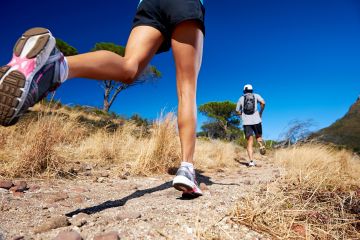Running Tips for Beginners
You might think running as a fairly straightforward form of exercise. You can just go and run until you can’t anymore! It’s free, you can do it anywhere, and it burns a good number of calories, too. While running can be a great form of exercise, beginners should know a few things before heading out.
If you haven’t recently been physically active or have experienced an injury, you’ll want to get medical clearance from your doctor. If you’re ready to go, it’s time to get your gear ready. First and most important, you’ll need a good pair of running shoes. You’ll want to look at shoes that are not only light, sturdy and fit well, but ones that are appropriate for your foot type and even the way you run. Over time, your shoes will eventually become worn and running in them could lead to injury. Ideally, you should replace running shoes as soon as they lose their integrity.
Your clothes should be comfortable and, if you’re running outdoors, suit the weather. You might also want to get a running hat to protect yourself from harsh sun rays as well as a running watch to track your times and distances. If you’re running at night, always take precaution. Wear reflective clothing and a head lamp.
Choose where you’ll run and learn the pros and cons of each terrain. On pavement? The park? Bush tracks? The beach? A race track? On a treadmill? Each surface has a different effect on your body and overall workout. Flat pavement is ideal for fast running and there is a low risk of turning your ankle. However, the hard surface can have a negative impact on your joints. Natural terrain like soil or grass provide cushioning, but the uneven surface and presence of roots and rocks can increase the risk of acute injury. Sandy terrain can be a really tough workout, particularly on your calf and thigh muscles. Running on tartan or the springy surface of a race track may seem ideal, but it can put a lot of stress on your Achilles tendon. Lastly, running on a treadmill provides convenience and cushioning, but your form will differ since your surface (the belt) is moving under you while you attempt to remain steady.
Like any other exercise, make sure to warm up for at least five minutes. Aside from stretching, try mobility exercises such as lifting the knees, rotating the hips, and circumduction of the ankles. Part of your warm-up should also include gradually increasing your intensity of running until you reach your regular running pace.
As a new runner, you don’t need to run the whole time. You’ll want to take it easy on yourself. You can do this by running, jogging and walking in intervals. Eventually, you can run more than walk and jog. Increase each interval by one minute during each workout. Additionally, when running, don’t waste your energy on taking huge strides. Take short, comfortable steps and remain relaxed. Focus on proper form. This will help with endurance and allow for a more effective workout. When you need to stop, slow down gradually rather than stopping suddenly. Be sure to cool down at the end of a run just as you warmed up at the start. Walking and static stretching is best.
When running, use your breath as your guide. Breathing shouldn’t be heavy and you should even be able to carry a conversation while running. Also, be sure you’re breathing through your nose. Also, ensure that you drink adequate water, especially in hot environments.
Sources: https://www.nhs.uk/live-well/exercise/running-tips-for-beginners/
https://www.verywellfit.com/running-beginners-4157126
https://www.runtastic.com/blog/en/8-extremely-useful-running-tips-for-beginners/




